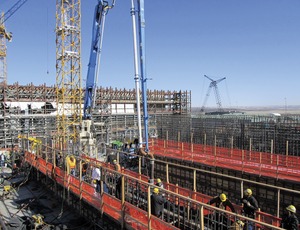
Gary Brunson, the U.S. Energy Dept. engineering director at the Hanford $12.2-billion Waste Treatment Plant project, claims Bechtel National Inc. is doing such a poor job of managing engineering at DOE's Washington state site that the contractor should be removed. In an Aug. 23 memo, Brunson declares that the company is "not competent to complete [its] role as the design authority for the [project], and it is questionable that BNI can provide a contract-compliant design."
Bechtel counters that Brunson's concerns do not mean the project is "fatally flawed." Still, Energy Secretary Steven Chu intends to lead a group of experts on a project site visit in early September.
In the 23-page memo to agency superiors, Brunson outlines 34 examples of questionable design decisions that were unsafe, too costly or "technically flawed," among other issues he calls "systemic problems." Costs and schedule have ballooned on the complex nuclear waste vitrification project since work started in 2001. Brunson wants Bechtel removed immediately as the project's design decision-maker and an independent team installed.
In a statement, DOE says it is reviewing the memo. "We recognize there are significant technical challenges remaining, some of which have existed for many years," the agency says. "Even as we work together to pursue solutions, however, the department continues to be frustrated with the lack of progress."
Frank Russo, Bechtel's project director, says Brunson's concerns have been voiced previously and that the plant's technical complexity and first-ever design decisions make differing opinions common. "The answers are never uniform," Russo says. "That everyone doesn't agree ... is not surprising, but we are working in harmony with the department." He adds that new information, such as declassified data showing that potentially explosive plutonium oxide could possibly be in the radioactive waste mix, has required revisiting design decisions. But Russo worries that the memo will generate a belief that the project is "fatally flawed, which we would defend it is not."
Hanford's largest project ever began with a budget of just over $4 billion and a goal to convert 56 million gallons of waste in aging and leaking underground tanks into vitrified glass for long-term safe storage. The project's scope and technical challenges soon changed. Dealing with unknown chemical mixtures in 1940s-era tanks pushed the budget higher and extended completion deadlines.
Russo says Congress decreed a $690-million-per-year budget for the plant and moved the completion date past 2016. State officials in Washington are threatening legal action if DOE cannot meet plant completion deadlines in a previous consent decree, says an Aug. 30 published report.
Among issues to be addressed by the Chu contingent involves the plant's so-called "black cells," a closed complex of pipes and vessels that would carry waste so radioactive during the plant's 40 years of operation that they could never be inspected or repaired by humans. A DOE inspector-general probe in May concluded that Bechtel failed to properly inspect the black cells, potentially exposing workers to high levels of radiation.
Russo says there are no issues raised in the Brunson memo that indicate any decision was made by Bechtel independently of DOE. "We don't do those [decisions] in some dark, smoke-filled room," he says. "The department is there looking at the options" and has concurred in all decision-making, Brunson adds. He is concerned that the memo could spur Congress to cut additional project funding.



Post a comment to this article
Report Abusive Comment